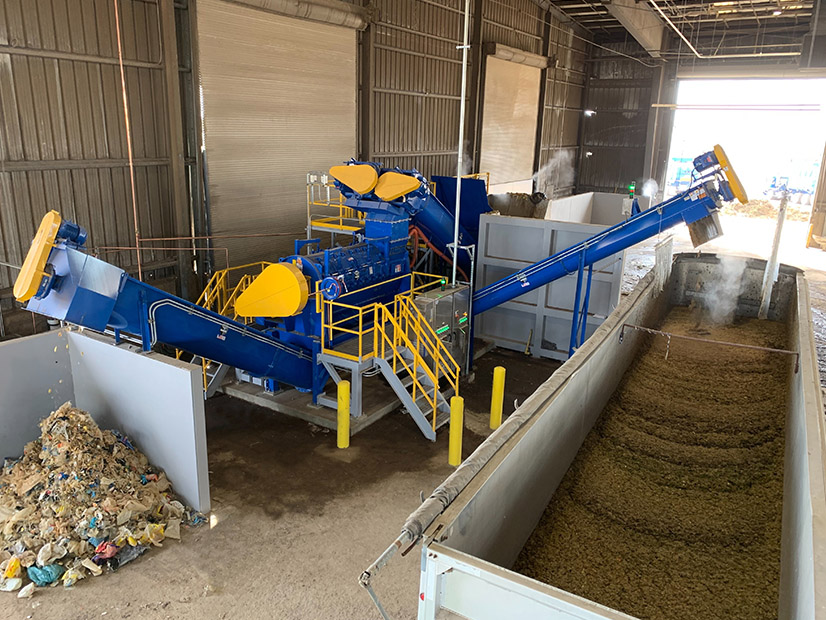
California laws that took effect at the start of 2022 included measures to increase electric vehicle charging, promote building decarbonization and eliminate greenhouse gasses from coal-fired cement plants.
Gov. Gavin Newsom signed most of the two dozen new energy laws last fall, but former Gov. Jerry Brown signed one of the new year’s most significant measures — Senate Bill 1383 — in 2016, with its implementation partially delayed five years.
SB 1383 sought to reduce methane emissions by requiring cities to divert 75% of organic waste from landfills by 2025. Regulations adopted under the bill took effect Jan. 1, requiring residents to put their food scraps into yard waste containers for recycling.
Much of that waste could be turned into biomethane to generate electricity, heat homes and fuel natural gas-powered vehicles, provided the infrastructure is built to turn the waste into gas through anaerobic digestion.
California expects to have enough anaerobic digestion facilities to handle 1 million tons of organic waste by 2025 but needs to be able to process 2.7 million tons to meet SB 1383’s goals, the California Department of Resources Recycling and Recovery (CalRecycle) said in an August 2020 report.
“Organics recycling and recovery infrastructure is growing but still needs significant expansion to provide the recycling capacity necessary to meet the SB 1383 disposal and methane reduction goals,” CalRecycle said.
Additional federal and state incentives are essential for meeting the goal, the department said.
Demand for the biomethane, which costs more than solar power and other renewable resources, must also increase.
Working under another measure, Senate Bill 1440 from 2018, the California Public Utilities Commission is currently developing targets for gas companies to procure enough renewable natural gas to generate 75.5 million MMBtu by 2030. (See Calif. Wants to Turn More Waste into Gas.)
EV Development
Several other measures that took effect seek to promote electric vehicles by accelerating the development of charging infrastructure, growing medium- and heavy-duty truck fleets and supporting workforce and supply chain development.
Assembly Bill 970 tries to address the slow progress of installing EV chargers that the state needs to meet its transportation decarbonization goals. (See California Needs Huge Number of EV Chargers.)
The bill seeks to create an expedited permitting process for applications to install EV charging stations by establishing timelines for cities and counties to follow. Under the bill, for example, an application to install 25 chargers or more will be “deemed completed” 10 days after it is submitted and “deemed approved” 40 days after it is completed.
Slow approval from local planning authorities has made it more difficult to meet the state’s need for hundreds of thousands of EV chargers to support the goal of putting 5 million EVs on the road by 2030, developers have said. (See Installing EV Chargers in Calif. is Slow, Costly.)
“In California, a new-service utility interconnection takes an average of 39 weeks or nine months to complete, in our experience, having built more than 200 stations today,” Matthew Nelson, director of government affairs for Electrify America, the largest network of fast-charging stations in the U.S., told a California Energy Commission workshop in October.
“The utility process for constructing the interconnection, the line extension and dropping the transformer … takes an average of 27 weeks, or more than six months, to complete,” Nelson said. “As a result, building stations in California costs 34% more for the exact same station than it costs us to build the same station in any other state.”
Another measure, Senate Bill 372, tries to make it more affordable for fleet operators to purchase medium- and heavy-duty zero-emission vehicles by establishing a fleet purchasing assistance program under the California Pollution Control Financing Authority, with priority given to fleets that impact low-income and disadvantaged communities.
Senate Bill 589’s aim is to expand the types of projects eligible for state clean transportation funding to include projects that develop in-state workforce and supply chains for zero-emission vehicle manufacturing and raw materials needed for batteries, such as lithium from the geothermal wells near the Salton Sea in far Southern California.
Building Decarbonization
Senate Bill 68 requires the California Energy Commission (CEC) to develop and publish on its website “guidance and best practices to help building owners, the construction industry, and local governments overcome barriers to electrification of buildings and installation of electric vehicle charging equipment.”
Topics include the “development of whole building electrification plans to help building owners prepare for future additions of electrical equipment.”
The bill authorizes the CEC to award funds from its Electric Program Investment Charge program to foster technological advancements that reduce the costs of electrifying buildings and benefit ratepayers.
Cement Plants
Senate Bill 596 requires the state Air Resources Board (CARB) to develop a strategy by the end of 2023 for eliminating greenhouse gas (GHG) emissions from cement plants by 2045.
Cement makers are the last major coal burners in California, with eight coal-fired cement kilns in the Mojave Desert and Central Valley producing inordinate amounts of pollution. Cement production accounted for 1.8% of GHG emissions in 2017, CARB said.
The cement industry has agreed it is important to decarbonize production by 2045 but contended it may be difficult to replace coal as a fuel source. (See Challenges Loom for Decarbonizing Concrete.)

